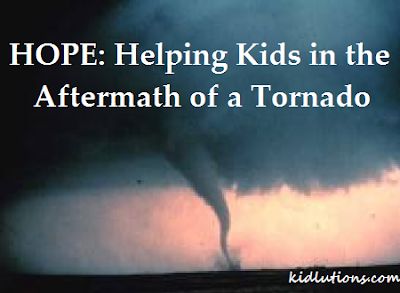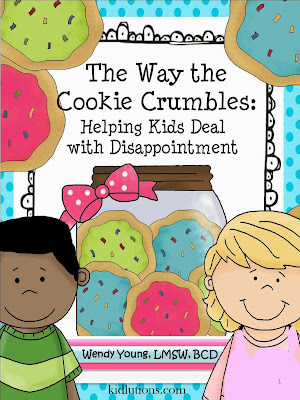Hope: Helping Kids in the Aftermath of a Tornado
As I watch images of the devastating tornado that ravaged Joplin, MO, my mind wanders to the youngest victims of the natural disaster. Helping kids and adolescents deal with trauma means keeping certain things in mind.
The National Child Traumatic Stress Center (NCTSC) recognizes the following common emotional reactions of children and family members exposed to a tornado include:
•Feelings of insecurity, unfairness, anxiety, fear, anger, sadness, despair, and worries about the future
•Fear that another tornado will occur
•Believing myths or folklore as to the cause of the tornado
•Disruptive behaviors, irritability, temper tantrums, agitation, or hyperactivity
•Clinging/dependent behaviors or avoidant and phobic symptoms
•Physical symptoms, such as stomachaches, headaches, loss of appetite, nightmares, or sleep problems
•Increased concerns regarding the safety of family members, friends, and loved ones
•School-based problems, with decreased motivation and school performance
Adolescents may differ from younger children in how they respond to a tornado or other natural disaster. Some believe they will not live long and may exhibit:
•Socially withdrawn, angry, or irritable
•Risky behavior
•Conflict with authority
The National Association of School Psychologists points out that the following can be reactions you may see in children/adolescents:
•Preschoolers—thumb sucking, bedwetting, clinging to parents, sleep disturbances, loss of appetite, fear of the dark, regression in behavior, and withdrawal from friends and routines.
•Elementary School Children—irritability, aggressiveness, clinginess, nightmares, school avoidance, poor concentration, and withdrawal from activities and friends.
•Adolescents—sleeping and eating disturbances, agitation, increase in conflicts, physical complaints, delinquent behavior, and poor concentration.
Helping Kids Deal in the Aftermath
The NCTSC recommends following the acronym SAFETY to assist children in coping and moving forward after a natural disaster
"S" Focus on safety first. That includes keeping your child close to you, telling her you will take care of things that are scary, shielding your child from frightening images and conversations, and keeping with familiar things and routines. (Remind your child that even though scary things have happened, there have been a lot of helper-people who have come together to assist. Firefighters, police officers and Emergency Medical Technicians. Although times are difficult, there are good people to help.)
"A" Allow expression of feelings. Acting out can be a way of asking for help. Help your child name how she is feeling, and tell her it's okay to feel that.
"F" Follow your child's lead. Listen to your child and watch his behavior to determine what he needs most.
"E" Enable your child to tell the story of what happened during and after the tornado. Children use play to tell their story. Encourage that. (You may see your child re-enacting the events of the disaster. I would advise that you allow your child to do this, without trying to guide them towards more "upbeat" play themes. This is how your child works through his feelings. I would also encourage drawing and play-doh use.)
"T" Ties. Reconnect with supportive people, community, culture and rituals. Simple things like a bedtime story they know well can remind your child of your way of life and offer hope.
"Y" Your child needs you. Sometimes just being with your child can help, even if you can't fix things. If you need to leave your child, explain when you will be back.
You can find an excellent handout from the NCTSC which further outlines how to promote each of the above.
Trauma is unlike any other experience. Children and teens have far less life experiences than adults to deal with the emotional heaviness of it all. If you have concerns about how your child is coping, check with your pediatrician or local mental health authority for a referral to a qualified and licensed mental health provider.
The National Child Traumatic Stress Center (NCTSC) recognizes the following common emotional reactions of children and family members exposed to a tornado include:
•Feelings of insecurity, unfairness, anxiety, fear, anger, sadness, despair, and worries about the future
•Fear that another tornado will occur
•Believing myths or folklore as to the cause of the tornado
•Disruptive behaviors, irritability, temper tantrums, agitation, or hyperactivity
•Clinging/dependent behaviors or avoidant and phobic symptoms
•Physical symptoms, such as stomachaches, headaches, loss of appetite, nightmares, or sleep problems
•Increased concerns regarding the safety of family members, friends, and loved ones
•School-based problems, with decreased motivation and school performance
Adolescents may differ from younger children in how they respond to a tornado or other natural disaster. Some believe they will not live long and may exhibit:
•Socially withdrawn, angry, or irritable
•Risky behavior
•Conflict with authority
The National Association of School Psychologists points out that the following can be reactions you may see in children/adolescents:
•Preschoolers—thumb sucking, bedwetting, clinging to parents, sleep disturbances, loss of appetite, fear of the dark, regression in behavior, and withdrawal from friends and routines.
•Elementary School Children—irritability, aggressiveness, clinginess, nightmares, school avoidance, poor concentration, and withdrawal from activities and friends.
•Adolescents—sleeping and eating disturbances, agitation, increase in conflicts, physical complaints, delinquent behavior, and poor concentration.
Helping Kids Deal in the Aftermath
The NCTSC recommends following the acronym SAFETY to assist children in coping and moving forward after a natural disaster
"S" Focus on safety first. That includes keeping your child close to you, telling her you will take care of things that are scary, shielding your child from frightening images and conversations, and keeping with familiar things and routines. (Remind your child that even though scary things have happened, there have been a lot of helper-people who have come together to assist. Firefighters, police officers and Emergency Medical Technicians. Although times are difficult, there are good people to help.)
"A" Allow expression of feelings. Acting out can be a way of asking for help. Help your child name how she is feeling, and tell her it's okay to feel that.
"F" Follow your child's lead. Listen to your child and watch his behavior to determine what he needs most.
"E" Enable your child to tell the story of what happened during and after the tornado. Children use play to tell their story. Encourage that. (You may see your child re-enacting the events of the disaster. I would advise that you allow your child to do this, without trying to guide them towards more "upbeat" play themes. This is how your child works through his feelings. I would also encourage drawing and play-doh use.)
"T" Ties. Reconnect with supportive people, community, culture and rituals. Simple things like a bedtime story they know well can remind your child of your way of life and offer hope.
"Y" Your child needs you. Sometimes just being with your child can help, even if you can't fix things. If you need to leave your child, explain when you will be back.
You can find an excellent handout from the NCTSC which further outlines how to promote each of the above.
Trauma is unlike any other experience. Children and teens have far less life experiences than adults to deal with the emotional heaviness of it all. If you have concerns about how your child is coping, check with your pediatrician or local mental health authority for a referral to a qualified and licensed mental health provider.







Comments